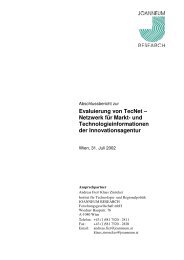roadMAP [PDF, 1.9 MB] - fteval
roadMAP [PDF, 1.9 MB] - fteval
roadMAP [PDF, 1.9 MB] - fteval
Create successful ePaper yourself
Turn your PDF publications into a flip-book with our unique Google optimized e-Paper software.
• There is always a goal conflict between structural goals and the limited time horizon of<br />
funding: Multi Actor systems are created; they develop their own lives and a deep interest to<br />
ensure a long-term existence which is a MAP goal. MAP funding on the other hand stops<br />
after some years and it is often not possible or wise to plan self-sustaining initiatives: A<br />
common MAP specific goal is to create self sustaining networks but this is often a naive idea:<br />
ambitious networks / structures / organisations will not survive without some public money<br />
and without a kind of “MAP governance”, namely if real scientific research shall be performed<br />
(see chapter 8 on governance).<br />
• As behavioural and institutional change is important for MAPs, quantitative goals are only to<br />
be applied in a limited form, namely impact on firms and some output indicators. Hence,<br />
qualitative goals are always necessary elements of MAPs (see chapter 7 on evaluation and<br />
monitoring).<br />
• As most MAPs show a large range of different aims, conflicting goals may occur, for<br />
example: the maintenance of scientific excellence, thus following the rules of basic science<br />
with a large amount of freedom, and an accelerated time to market; or as an other example:<br />
long term research and SME inclusion. Such conflicting goals should and can be dealt with in<br />
advance, often being easy to solve at this stage: With proper rules science can flourish and<br />
be relevant.<br />
4.4.2 Formulation of goals and evaluation design as one interlinked process<br />
A crucial point with regard to monitoring and evaluation procedures is the synchronisation of<br />
goal formulation and evaluation procedures before starting the MAP, e.g. in the design phase it<br />
is necessary to formulate goals that are suited for evaluation. Generally spoken, evaluations are<br />
more difficult than in other programmes (see chapter 7 on evaluation and monitoring): As<br />
mentioned above, MAPs pursue a lot of aims, quantitative and qualitative, many of them with a<br />
structural character which means that they are very difficult to measure – at least in the short<br />
run. In the design process attention should also be given to the definition of relevant indicators.<br />
As MAPs are complex, goals and criteria and also indicators are multi-dimensional. However,<br />
summative performance measurement rapidly reaches its limits. For this reason formative,<br />
learning-oriented evaluation approaches can and should be used – partly in competition, partly<br />
complementary to the summative ones. On the basis of multiple evaluation results on the<br />
relationship between programme targets, measures and impacts, spectra of alternative paths of<br />
further development of a programme can be shown, alternatively regarding adjusted targets and<br />
differing starting points, addressees and time and objective range. Such information can aid the<br />
actors to play their strategic games more transparently and "more effectively" in the general<br />
interest.<br />
<strong>roadMAP</strong> 25


![roadMAP [PDF, 1.9 MB] - fteval](https://img.yumpu.com/21079876/30/500x640/roadmap-pdf-19-mb-fteval.jpg)

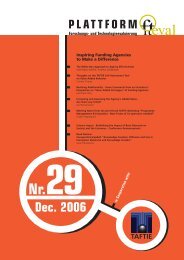
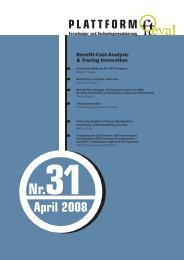
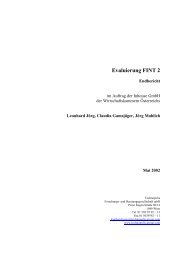
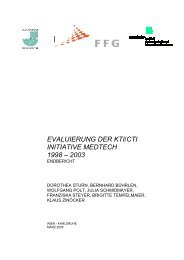
![GuggenbergeronBoku [PDF, 73.4 KB] - fteval](https://img.yumpu.com/21024081/1/184x260/guggenbergeronboku-pdf-734-kb-fteval.jpg?quality=85)
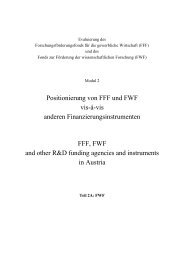

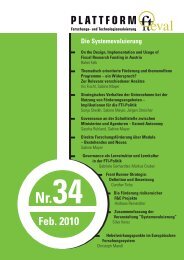
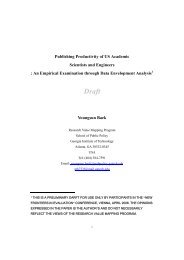
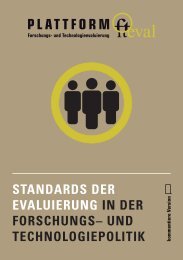
![ITF_Energietechnik [PDF, 39.6 KB] - fteval](https://img.yumpu.com/20959076/1/184x260/itf-energietechnik-pdf-396-kb-fteval.jpg?quality=85)
![Evaluation Standards [PDF, 120.8 KB] - fteval](https://img.yumpu.com/20931509/1/184x260/evaluation-standards-pdf-1208-kb-fteval.jpg?quality=85)
